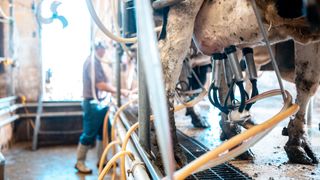Under the new federal order, U.S. dairies must now send raw milk samples to the U.S. Department of Agriculture (USDA) so the agency can test them for bird flu. The move, announced Friday (Dec. 6), builds on existing efforts by the USDA and other officials to track the spread of bird flu in dairy herds across the country.
As of Dec. 5, H5N1 — a subtype of bird flu — has been detected in 720 dairy herds in the U.S. this year. At least 35 people have contracted bird flu as a result of working around infected cows. A further 21 people have been infected through contact with sick birds, and there are two additional cases whose sources of infection are unknown.
Early in the outbreak, the USDA mandated that any milk cow shipped across state borders be tested for H5N1 first and that any positive tests be reported to the agency. It also launched the voluntary Dairy Herd Status Program, which dairy producers can join to monitor for infections through weekly bulk milk samples. But as of December, only 75 herds in 17 states were being tracked through the program.
Now, with the federal order, bulk milk testing will be mandatory across the country.
“This new milk testing strategy will build on those steps to date and provide states with a roadmap to protect the health of their dairy herds,” Agriculture Secretary Tom Vilsack said in the USDA announcement.
“Among many consequences, it will give farmers and farm workers better confidence in the safety of their animals and their ability to protect themselves,” he added. “And it will put us on a path to quickly control and stop the spread of the virus across the country.”
Specifically, the order mandates that, upon request, any entity that ships or holds milk for pasteurization submit samples to the USDA. It also requires that herd owners with cows that test positive provide information to the USDA to help track the spread of the disease among cattle. Finally, private laboratories and state veterinarians must report any raw milk samples that test positive for bird flu to the USDA.
The main purpose behind the order is to help officials determine the scope of the outbreak and track its spread. The USDA said that where needed, “enhanced biosecurity measures” can be implemented to help prevent the spread to additional cows. The increased surveillance could also inform strategies to help protect farm workers from infection.
So far, there’s no evidence that H5N1 is spreading from person to person; so far, people have only gotten the virus from animals. However, a study released Thursday (Dec. 5) highlighted just how little the virus would have to evolve to spread between people.
A single mutation affecting one of the virus’s key proteins could make it “unlikely” to bind to human cells, setting up a major domino whose fall could lead to a pandemic.
“The more people that get infected, the more likely it is that … that mutation will be selected for,” Ian Wilson, a structural biologist at the Scripps Research Institute and one of the study’s authors, previously told Live Science.
According to Reuters, the new testing plan will begin Dec. 16, initially in California, Colorado, Michigan, Mississippi, Pennsylvania and Oregon. The USDA statement said tracking bird flu will help officials ensure that the commercial milk supply remains safe. Importantly, however, the commercial milk supply is already pasteurized — heated to kill germs — so any H5N1 present in the milk is neutralized before it’s sold.
Several studies have confirmed that pasteurization inactivates the virus. However, health officials warn against consuming products made from unpasteurized or “raw” milk, which could pose a risk of infection if contaminated with H5N1. Recently, California-based dairy company Raw Farms issued a recall after its products tested positive for the virus. Drinking raw milk also poses a risk of other serious infections.
